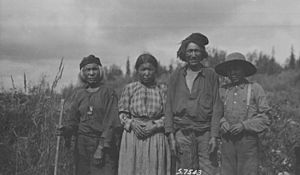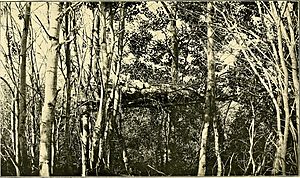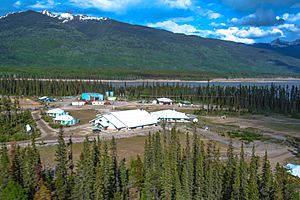Sekani facts for kids

Group of Sekani people at Fort Nelson, British Columbia
|
|
| Regions with significant populations | |
|---|---|
| Canada (British Columbia) | |
| Languages | |
| English, Sekani | |
| Religion | |
| Christianity, Animism | |
| Related ethnic groups | |
| Tagish, Tahltan, Kaska, Carrier, Beaver |
The Sekani people, also known as Tse’khene, are a First Nations group in Canada. They belong to the Athabaskan-speaking family. Their traditional lands are in the northern part of British Columbia, especially around the Finlay and Parsnip Rivers.
The Sekani share borders with other Athabaskan-speaking groups like the Babine to the west, Dakelh to the south, Dunneza (Beaver) to the east, and Kaska and Tahltan to the north. In more recent times, they also have Cree communities as neighbors to the east.
The Sekani people call their language tsek'ene or tθek'ene. When they add "Dene" (which means "people"), it forms "people on the rocks." The name "Sekani" is an English version of this term. You might see older spellings like Secunnie or Sikani.
Sekani Culture and Traditions
The Sekani people traditionally lived by hunting animals and gathering plants. While they did eat fish, hunting was a very important part of their diet. They hunted more than their neighbors, the Carrier and Babine peoples.
Berries were a big part of their plant-based food, especially blueberries.
In the past, the Sekani had special ways of caring for their deceased. Sometimes, they would cover the person with the brush hut they had used in their last days. Then, the community would move away from that spot for a while. Important people were sometimes placed in coffins raised on platforms or in trees.
Sekani Language
The Sekani language is an important part of their heritage. It is part of the larger Athabaskan language family.
Sekani First Nations Today
Today, three main groups identify as Sekani First Nations:
- Kwadacha First Nation
- McLeod Lake Indian Band
- Tsay Keh Dene First Nation
Also, the Takla Lake First Nation, which mostly identifies as Carrier, has many people with Sekani family roots. Until recently, many members of the Takla Lake First Nation also spoke the Sekani language.
Here are some details about these communities:
- Kwadacha First Nation
- This group includes both Sekani and Kaska Dena people.
- Their main community is at Fort Ware (now called Kwadacha). This is about 570 kilometers north of Prince George, British Columbia.
- They live where the Fox, Kwadacha, and Finlay rivers meet in the Rocky Mountain Trench.
- Their population is around 425 people.
- McLeod Lake Indian Band
- They are also known as the ‘McLeod Lake Tse'Khene First Nation’.
- Their main community is McLeod Lake, located on the north end of McLeod Lake. This is about 150 kilometers north of Prince George.
- Their population is around 618 people.
- Tsay Keh Dene First Nation
- This group was formerly known as the ‘Ingenika Indian Band’.
- Their traditional lands stretch from Mount Trace in the north to the Nation River in the south.
- Their offices are in the city of Prince George, but their communities and reserves are north of there, near Lake Williston.
- Their population is around 431 people.
- Takla Lake First Nation
- This Nation was formed in 1959 by combining the North Takla Band and the Fort Connelly Band.
- Their main community, Takla Landing, is about 320 kilometers north of Prince George, B.C., on the eastern shore of Tatl'ah Bun (Takla Lake).
- Most Takla Lake people now speak Canadian English and the Babine dialect of Babine-Witsuwit'en.
- In the past, many also spoke Sekani, and some spoke Gitxsan or the Stuart Lake dialect of Carrier.
- The community generally identifies as Carrier.
- Their population is around 703 people.
See also
 In Spanish: Sekani para niños
In Spanish: Sekani para niños



